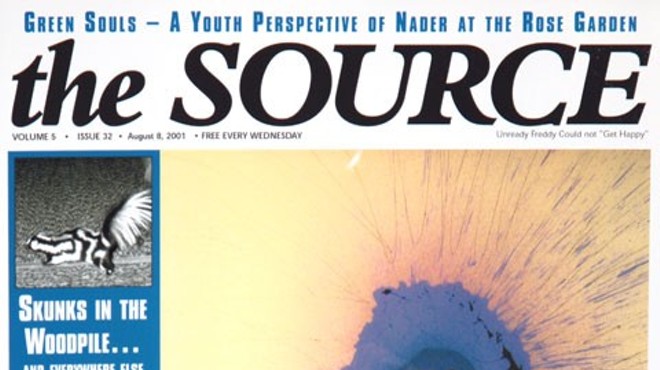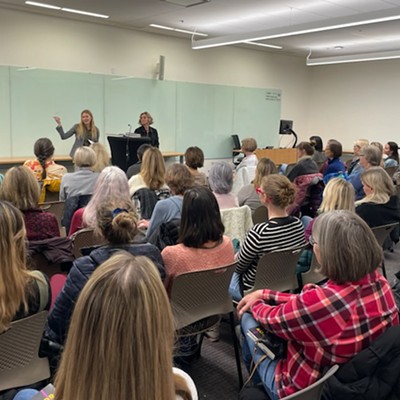In '04, the big to-do centered around the historic Crane Shed in the Old Mill district. Developers wanted it torn down, and the city eventually agreed. But the story wasn't over yet... Next up: tearing down the building in the dead of night.
Even though its former site on Industrial Way is only an empty field dotted with rubble now, Bend's historic crane shed could leave a permanent legacy by reforming the way the city handles historic preservation.
The owners of the shed, Crown Invest Group LLC, tried for months to get permission from the Deschutes County Historical Landmarks Commission to tear the huge 67-year-old structure down so they could replace it with a new mixed-use building. Last August, City Attorney Peter Schannauer advised the city council it had no legal power to prevent demolition. Following that advice, the council voted 5-2 not to challenge Crown in court.
The next evening, without obtaining a city demolition permit first, the developers sent bulldozers to tear the 500-foot -long building down. A judge later penalized them $100,000 for that act, and the state Department of Environmental Quality fined them $64,000 for failing to take steps to prevent the spread of asbestos during demolition. The developers are appealing the $100,000 penalty.
The crane shed destruction prompted city officials to talk about putting teeth in the city's historic preservation ordinance so that other old structures could be spared the same fate. Last week, Councilor John Hummel told the Source Weekly that the idea "is still very much afloat."
"The latest [plan] is that the landmarks commission will be preparing some draft language that will give the council authority to deny demolition in certain circumstances," he said. He added that he'd bring the measure before the council "in January maybe February at the latest [and] see if the council will support it. I haven't done a vote count yet."
Landmarks Commission Planning Associate Pat Kliewer said that by the end of this month she would get a draft of the ordinance to City Planning Director James Lewis, who would then polish and clarify it before turning it over to the council.
Kliewer said members of the landmarks commission are eager to get a revised ordinance in place because the city is thinking about increasing building height limits downtown to as much as 70 feet, which could "put several of these [historic] buildings in jeopardy."
Hummel said Councilor Bill Friedman had expressed concern that "if we don't let the owner demolish [a historic] building and he doesn't have the money to rehab the building, it'll just crumble. That's definitely something to consider—I think he raises a valid concern. There have to be some tradeoffs."
To illustrate the kind of tradeoffs he's talking about, Hummel pointed to a Portland ordinance that compensates owners of historic buildings by allowing them to "put something on another part of the property that normally would not be allowed." The owner can then use the money generated by that new development to rehabilitate the historic building.
One wild card in the deck is Measure 37, a ballot measure passed by the voters last month that entitles property owners to compensation if government actions result in a loss of value to their property. Hummel noted that Measure 37 is "unknown and untested, and we don't know if the legislature is going to make a change." However, he added, regardless of Measure 37, "We can't shirk our responsibilities for historic preservation in the city."
Kliewer indicated Measure 37 might not have much impact on historic preservation decisions because a 1997 state law provides that no building or site can be assigned historic status without the owner's consent.
She also noted that, far from reducing a property's value, "The opposite is true—historic designations raise property values between 5 and 300 percent."
While city and county staff tinker with the landmark ordinance, the Crown partners are preparing to ask the Bend Urban Area Planning Commission for a height variance to allow them to build a new structure as high as the original crane shed, instead of following the 35-foot limit presently applied to buildings in the Old Mill District area.
Kliewer, for one, doesn't think that's a good idea.
"Across the entire country, it is discouraged to tear down a historic building and replace it with another one of the same size," she said. A policy that rewarded developers for tearing down old buildings by giving them height variances for new buildings would be ill-advised, she said: "There's something morally wrong with that, and it's not good planning policy either."
She said some members of the landmarks commission might testify on the height variance issue when it comes before County Hearings Officer Karen Greene.
Besides the height variance, the developers are asking for a modification of the master plan for the area to allow their building. Indications are that request may have tough going: Last week, Lewis and other city staff recommended that the planning commission deny the request on the basis of the expected traffic impacts from the new building. The planning commission hearing originally had been scheduled for last Monday but has been postponed indefinitely at the developers' request.
Finally, the crane shed controversy has prompted a discussion about the organization of the landmarks commission and whether the City of Bend should have its own commission, separate from the county's.
Kliewer explained that the commission currently has nine members - four representing the county, once each from the cities of Bend, Redmond and Sisters, one from the Historical Society and one from the Pioneer Association. Considering that roughly 80 percent of the designated historical structures in the county are in Bend, many feel that Bend is underrepresented.
Although the discussions are "extremely preliminary right now," Kliewer said, one idea that's being talked about is to give Bend four commission members and reduce the county's representation to one. Another is to have the city representatives appointed directly by the city mayors instead of having to be approved by the county commissioners, as they are now.
As for creating a separate historical landmarks commission for Bend, Kliewer said, "I haven't seen any evidence that they need it."
Hummel agrees: "I've always said if it ain't broke, don't fix it."
He added that the problem was not the structure of the commission—rather, "the problem was the ordinance, that we didn't have power to block demolition." As long as the problem is fixed, he believes, it doesn't much matter whether there's a separate Bend commission or not.
"I don't see the point of wasting time and effort on it," he said, "but it will work out either way."




















